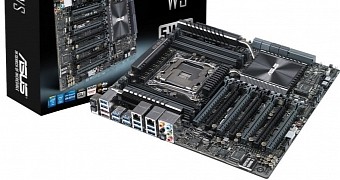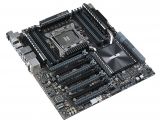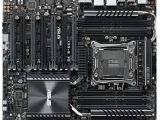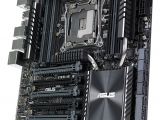ASUS has finally released the X99-E WS motherboard, a product we have been keeping a close eye on since well before it even got officially previewed. Primarily because of the unusual socket it boasts.
This is actually the strange part about the press release. ASUS has formally launched the X99-E WS motherboard, sure, but it hasn’t mentioned the really important parts. Or at least the long term implications.
Fortunately, we caught wind of them a while ago, so we can reiterate them. First off, the socket is not a normal LGA 2011-3, although it does support Haswell-E Intel CPUs just fine.
Instead, it has six extra pins, which allow it to accept Haswell-EP Xeon CPUs as well. More importantly, it will supposedly let the mainboard accept Intel Skylake CPUs. The ones set for July 2015 release.
According to a source that will remain anonymous, the socket is called LGA 2017-A, unofficially at least. In essence, this all means that the motherboard won't become obsolete in 9 months (when Broadwell gets replaced by Skylake). Instead, it should be good for 18 months to 2 years.
This is important, because the X99-E WS is a commercial/server mainboard. Sort of. You see, it is the only ASUS motherboard listed on both the consumer and commercial/business parts of ASUS' website.
The traits of the X99-E WS
There is a single CPU socket available, but seven PCI Express 3.0 x16 slots, which is more than double what Core i7-5xxx CPUs can cope with (40 PCI Express lanes). Yet they can all work in full x16 mode at once, more or less, thanks to the PEX 8747 PCIe controller that adds 48 more lanes.
It should let you set up quad-channel NVIDIA/AMD SLI/CrossFireX graphics card multi-setups and have room for a PCI Express SSD or some other add-on card left over.
The board also has the honor of being the first server board with 12K solid capacitors, which withstand up to 12,000 hours of temperatures as high as 105°C / 221°F. For normal use at 65°C / 149°F, they should last for over a century (1.2 million hours). A lot more than the rest of the platform is likely to last.
ProCool is another asset, eliminating the hollow areas of normal power connectors, making the connection to the motherboard both stronger and more efficient (lower impedance and better heat dissipation).
An integrated Dr. MOS (saves space and reduces operating temperatures) and ASUS-exclusive Beat Thermal Chokes II further enhance efficiency and stability.
Furthermore, administrators may be glad to learn of the ASUS Q-Code Logger, a button that sends four-digit port 80 code logs to a flash drive, for easier diagnosis of problems that the Dr. Power LED doesn't make obvious in its messages.
The specifications
There's little point in copying the thorough description that ASUS already has of the X99-E WS. Instead, we'll just say that the M.2 SSD implementation (the only new technology of the year) is really good, with support for 2260 (60mm) and 2280 (80mm) devices of up to 1.8 GB/s or more. Two SATA Express ports round up the high-end storage feature set.
Since this is a rare platform that has the honor of selling both as server and consumer mainboard, you might find it in retail for (we assume) $499 / €499.

 14 DAY TRIAL //
14 DAY TRIAL // 


